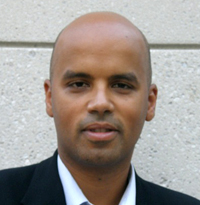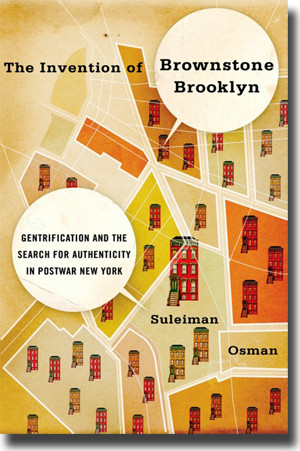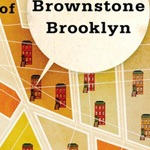Many Park Slope newcomers — and even some longtime residents — may not realize how much Brownstone Brooklyn has changed over the decades, going from a blighted community in the 1960s and ’70s to an often pricey cultural capital today. The journey from undesired neighborhood to a coveted one offers important insights into how we view our neighborhood and into how cities evolve over time.

Suleiman Osman, a Park Slope native and assistant professor of American studies at George Washington University, takes a look at that journey in his new book, Brownstone Brooklyn: Gentrification and the Search for Authenticity in Postwar New York. On Wednesday, April 6, at 7 p.m., he will be reading from his work at The Community Bookstore, 143 Seventh Ave. between Carroll Street and Garfield Place. Atlantic Yards Report blogger Norman Oder will moderate a discussion after the reading.
The Park Slope Civic Council is co-sponsoring this look into our community’s history. Osman made extensive use of some valuable Civic Council resources in his research: notably, our archives, as well as the vast knowledge of Civic Council trustee and past president Thomas Miskel and member and former trustee Ann Halkhoff.
In this excerpt from The Invention of Brownstone Brooklyn, Osman begins the exploration from urban decay in 1960s “North Gowanus” to the “New Brooklyn” we know today.
On November 22 1966, a small group of city construction workers arrived at the corner of State and Nevins Street in Brooklyn with orders to raze an abandoned brownstone. Having recently gained possession of the dilapidated four-story building through non-payment of taxes, the city had become concerned that the empty townhouse was a gathering place for homeless men and drug users and decided to demolish it. For local residents, the sight of helmeted workers and bulldozers was a common one. Although only a few blocks away from the borough’s downtown, “North Gowanus,” as some locals called it, was a struggling inner-city district hit hard by the same trends affecting most American cities in the 1960s. A once thriving industrial economy centered around the Gowanus Canal and waterfront was fading as firms left for the suburbs and the South. Working-class white residents anxious about the changing racial composition of the area and declining work opportunities fled for Staten Island, New Jersey, and Long Island. African-American and Puerto Rican migrants arrived on the heels of departing white ethnics in search for work, but soon found themselves trapped in decaying tenements surrounded by abandoned townhouses. To stem the spread of “blight” and urban decay, ambitious city planners hoped to raze and rebuild, replacing outdated Victorian housing with modern high-rises, open space, and green parks. A few blocks away, the city had recently blasted several square blocks of brownstones and would soon complete the enormous Wyckoff Gardens low-income housing project.
 On this morning, however, workers were confronted with the unexpected: a group of 30 members of the “Boerum Hill Association” stood in front of the building protesting with placards, bullhorns, and pamphlets. An organization of young homeowners who recently moved to the area, the BHA demanded that the city halt demolition of the building. An abandoned lot would scar the townhouse-lined block. Some sat in front of the equipment. Others held signs saying “Don’t Destroy Our Neighborhood,” and “People Need Homes — Not Parking Lots.” Two housewives sat at the entrance holding infants. Another group of mothers lined up five strollers bumper-to-bumper in front of the stoop, forming a “baby-carriage brigade” of protest. Hanging on another pram, a sign invited spectators to attend a house tour organized by the new group. “Care Don’t Clear!” cried one of the protesters.
On this morning, however, workers were confronted with the unexpected: a group of 30 members of the “Boerum Hill Association” stood in front of the building protesting with placards, bullhorns, and pamphlets. An organization of young homeowners who recently moved to the area, the BHA demanded that the city halt demolition of the building. An abandoned lot would scar the townhouse-lined block. Some sat in front of the equipment. Others held signs saying “Don’t Destroy Our Neighborhood,” and “People Need Homes — Not Parking Lots.” Two housewives sat at the entrance holding infants. Another group of mothers lined up five strollers bumper-to-bumper in front of the stoop, forming a “baby-carriage brigade” of protest. Hanging on another pram, a sign invited spectators to attend a house tour organized by the new group. “Care Don’t Clear!” cried one of the protesters.
As the construction workers watched the protesters they were likely taken aback. Most surely had not heard of “Boerum Hill.” While some referred to area as “North Gowanus,” for most Brooklynites in the 1960s the block was an indistinguishable part of South Brooklyn — a vaguely defined zone consisting of two congressional districts that extended about two miles from the docks and factories by the East River inland to majestic Prospect Park. The workers perhaps too were taken by the accents and dress of the protesters. While South Brooklyn was primarily a white, working-class district with a growing number of African-Americans and Puerto Ricans, the members of the BHA were young white-collar professionals. Robert T. Snyder, the president, was a Columbia educated labor lawyer. David Preiss, the spokesman at the protest, was an editor of American Artists Magazine. The protesters spoke confidently and articulately. Their speech, with all the shibboleths of Manhattan’s educated class and no trace of Brooklyn brogue, seemed incongruous with their surroundings.
They called themselves “The Brownstoners.” They first began to appear in Brooklyn Heights in the late 1940s. Artists, lawyers, bankers and other white-collar workers migrated to the aging Gold Coast district restoring old townhouses and moving into run-down tenements. By the 1960s, white-collar professionals priced out from Manhattan flooded into surrounding areas in search of cheap housing. “More and more people now are packing up, moving out of their aseptic uptown apartments,” explained New York about “brownstone fever” in 1969, “making new homes out of old, forlorn but solid and roomy brownstones, restoring them to pristine glory.” As brownstoners spilled past the boundaries of Brooklyn Heights, they created new names for revitalizing blocks. “Cobble Hill” was named in 1958. “Boerum Hill” and “Carroll Gardens” soon followed. By the mid 1970s, few people remembered the name South Brooklyn. In brochures, newspapers, and real estate guides, the area had become “Brownstone Brooklyn” — a constellation of revitalized townhouse districts like Clinton Hill, Park Slope and Prospect Heights.
Brownstoners, however, believed they were involved in something more than a renovation fad. “Brownstoning,” as they called it, was a cultural revolt against “sameness,” conformity and bureaucracy. In a city that was increasingly technocratic, Boerum Hill was a “real neighborhood,” a vestige of an “authentic community” lost in a modernizing society. “Many enthusiastic brownstoners, particularly those recent escapees from ‘the boring sameness of suburbia,’ emphasize the social value of their decision to live in the city,” explained The Brownstoner, a local newsletter, in 1969. Where Midtown Manhattan and the suburbs were atomizing and mass-produced, Boerum Hill appeared “historic” and “diverse.” “On Wyckoff Street, an eccentric block of three-story workmen’s cottages have been rescued by young homemakers and turned into a happy, house-proud community,” described The Boerum Hill Times in 1974. “Indeed it’s quite possible to feel, while walking tree-lined streets, that one has broken through the time barrier and landed smack in the middle of the 19th century. Gentle ghosts of ladies in hoops skirts and gentlemen in frock coats can almost be seen among the leafy shadows.” “My children can grow in a stimulating atmosphere and be exposed to many new experiences,” explained a brownstoner about his move to Boerum Hill. “They will know and understand people of all economic backgrounds, and they will have the cultural, educational, and institutional facilities of New York City at their doorstep.”
Brooklyn’s young white-collar émigrés moved there with a sense of zeal. They started block associations, organized street festivals, and opened food cooperatives to foster a sense of “community,” “place” and “history.” As they planted trees and dug community gardens in abandoned lots, they described themselves as “greening” the city and echoed the themes of a nascent environmental movement. They avidly renovated houses, stripping away paint and tin siding, as well as symbolically ripping off the trappings of mass consumer society to return to an older, more authentic form of life. But as their poorer neighbors warily eyed them hammering and planting, some brownstoners had a gnawing sense of doubt about their project. “I wonder … are my own home improvements and those of my neighbors … are the friends that are brought in to buy that decrepit rooming house down the street … are our civic activities … and our walking tours,” wondered one brownstoner in 1969, “all part of a trend that is turning our own neighborhoods into suburban-like middle-class ghettoes?”
By 1980, Boerum Hill had dramatically changed. Fifteen years after they demonstrated on State Street to protect the fledgling enclave, the members of the BHA found themselves the targets of a new wave of protests. In August, “The Displacement Report,” a pamphlet produced by Accion Latina and the Tenants Action Committee, began to circulate around the neighborhood. “Revitalization,” the group complained, was resulting in the displacement of low-income renters from the area. Greedy speculation by real-estate agents and middle-class homeowners was leading to the eviction and harassment of long-time residents of color. Local bodegas and storefront churches were pressured to close. Most striking though was a new word that the pamphlet had adopted from headlines in the media: “gentrification.” The members of the BHA perhaps read the pamphlet with a sense of defensiveness. Had they not arrived in Boerum Hill with the fresh idealism of the 1960s? How had they become villains? Some perhaps read the pamphlet more wistfully. Decades ago, they had arrived in search of an authentic community lost in Manhattan and suburbia. But had they ironically destroyed the authenticity they once craved?
Whether referred to as “gentrification,” “brownstoning,” “neighborhood revitalization” or the “back-to-the-city movement,” the influx of white-collar professionals into low-income central city areas has been one of the most striking developments in postwar urban history. Once red-lined by banks and slated for large-scale urban renewal in the 1950s, Brownstone Brooklyn’s enclaves by the 1980s had some of the most expensive real estate in the nation. A Brooklyn brownstone, once considered a symbol of blight in the 1940s, today is de rigeur [ITAL] for New York’s wealthy and educated. With hip bars and cafés, used bookstores, yoga studios, and renovated townhouses, Brownstone Brooklyn is no longer regarded by the public as blighted, but instead is both celebrated and reviled as site of cultural consumption for a new middle class. Once dismissed by sophisticated Manhattanites, Brownstone Brooklyn since the 1990s has even begun to eclipse its neighbor as an intellectual and cultural center. “Manhattan: The New Brooklyn?” asked a local magazine in 2002, playfully inverting the relationship between province and metropole.
Reprinted from The Invention of Brownstone Brooklyn by Suleiman Osman with permission from Oxford University Press, Inc. © 2011 by Oxford University Press, Inc.
from the March 2011 Civic News

